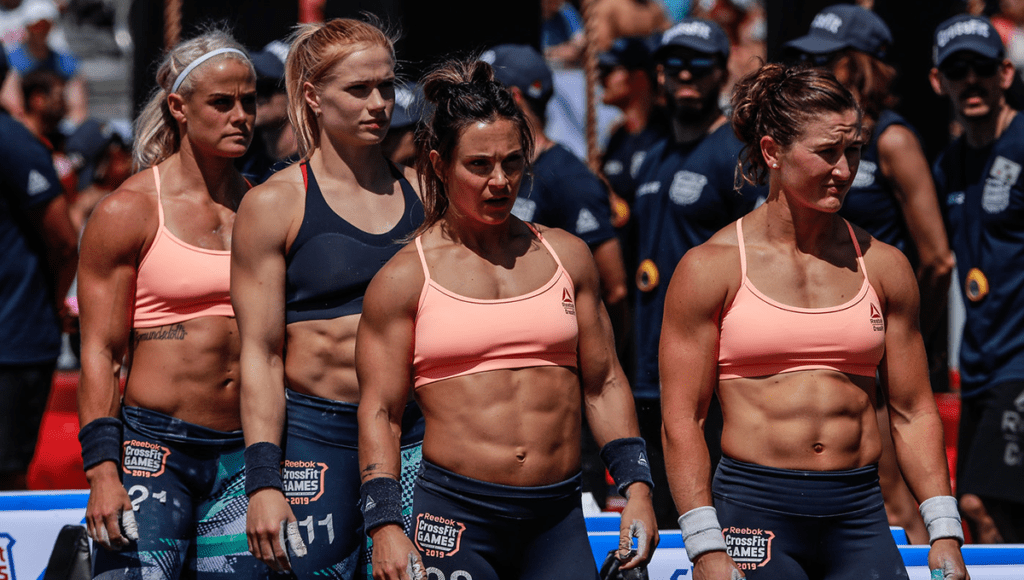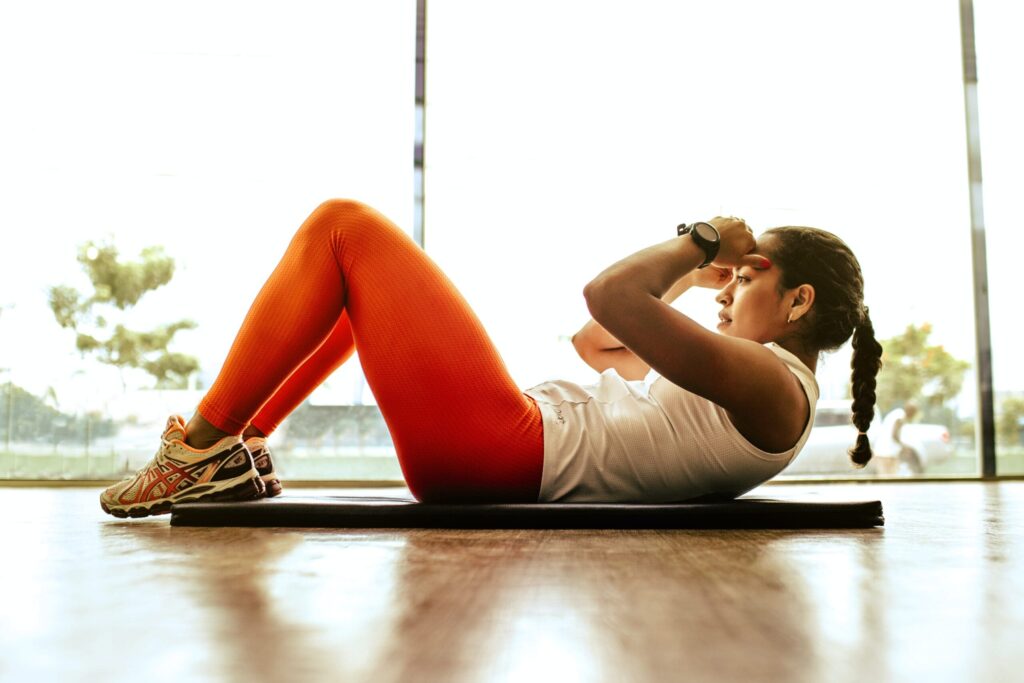This thorough guide will teach you all about sit-ups.
What are sit-ups?
A sit-up is an exercise that works the rectus abdominis, a large muscle that extends vertically down the front of the stomach. Crunches help strengthen your abdominal muscles, which can help you improve your core strength. It’s a simple exercise you can do at home or in the gym, but it’s not just a great core workout — it can also help you build endurance in that area of your body.
Many people do crunches because they want to stay fit, but they can also be used as part of recovery after an injury to this part of the body or surgery.
Which muscles do crunches work?
Sit-ups mainly exercise the rectus abdominis, external oblique and internal oblique. The erector spinae also contract to support the spine when flexed.
When you start doing a sit-up with your legs bent, hip flexors The psoas and iliopsoas, for example, help lift your torso off the floor and help lift your torso by contracting their respective muscles during hip flexion (forward bending of the waist).
 source: Photo courtesy of CrossFit Inc.
source: Photo courtesy of CrossFit Inc.On top of that, the hips are also used a lot when lifting yourself off of sloping surfaces like exercise mats or the floor, as they act eccentrically to prevent injuries from lengthening under load while standing upright.
What are the benefits of sit-ups?
Crunches are one of the most effective exercises to strengthen your core, support your spine and prevent back pain.
A strong core also helps you build better posture and balance, making it easier to perform everyday tasks like lifting heavy objects or carrying groceries.
Crunches can be done quickly, but if you have time to focus on longer workouts, it’s best to change your routine so you don’t burn out too quickly.
If you’re just starting out, do 1 set of 10 at a slow pace until you’re comfortable enough with the movement, then increase the speed or repetitions.
Common Sit-Up Mistakes
- Avoid straining your neck. While it may be tempting to stretch your head back and pull it, this can lead to injury and pain. If you’re in doubt, try lying on a yoga mat instead of the floor for more support.
- Avoid pulling your head or using power when lifting yourself off the ground. In both cases, doing so increases the risk of injury; instead, use steady pressure to push away from the floor and don’t apply any extra force on the floor beyond what is required to complete the movement.
- Avoid sagging or splaying your hips as much as possible; both will make it harder for you to sit up straight and maintain good posture in all aspects of this exercise and during everyday activities like walking or sitting/standing. *
Are crunches right for me?
If you have a back injury, neck injury, or shoulder injury, do planks instead of crunches.
If you have a knee injury, do planks instead of crunches.
What are core muscles?
The core muscles are a group of muscles that surround the spine, pelvis, and hips. They are used for many exercises and activities, including walking, running and sitting up. Core muscles include:
- Rectus abdominis (“six pack” muscles)
- External Obliques (under your rectus abdominis)
- Internal oblique muscle (around the rectus abdominis)
These three muscles form a triangle around your abdomen. When you pull them together on your sides at the same time, you create what’s called a “bracing motion.”This bracing action supports the spine during bending or twisting movements — such as when lifting heavy objects from one place to another — and also helps stabilize the pelvis during walking or running movements
Are crunches good for beginners?
Crunches are a great exercise for beginners because they are relatively easy to learn and progress. This makes them suitable for those who may not have much exercise experience or those looking to improve their fitness levels.
 source: Jonathan Borba on Unsplash
source: Jonathan Borba on UnsplashCrunches can also work backwards by reducing the number of repetitions, increasing the intensity of each repetition, or slowing down the movement. All of these modifications will help you increase your strength while making sure you don’t strain your back or neck muscles prematurely during your workout.
Can you do sit-ups during pregnancy?
The problem with crunches is that they put too much pressure on your back, which can lead to injury to your spine. If you are at high risk of pregnancy, or have any medical conditions, avoid doing crunches as they may aggravate them further.
If you’re not sure whether you’re at high risk for pregnancy, here are some symptoms to look out for:
- You’ve had more than one child before
- You were overweight (BMI over 30) before pregnancy
- you are over 35 years old
How can I make crunches harder?
There are several ways to make crunches harder.
- Use a weight plate or weighted vest. You can use a plate, dumbbells, or even a water bottle filled with sand.
- Use a resistance band. The straps should stretch between your hands when you sit up, or rest on your waist during exercise (if you’re wearing shorts). This can also be used as another way to increase the intensity when performing standard crunches by having someone hold one end of the band while you lie on the band and perform each repetition.
- Do slow “squat” sit-ups: Start in a push-up position, but keep your arms straight and your chest hovering above the floor before lowering yourself for each repetition; this variation requires increased core stability , because there is no momentum from swinging up and down as quickly as normal crunches do!
How to make crunches easier?
To make crunches easier, you can use a stability ball or a sit-up bench. Partial crunches are also a great way to get the benefits of full crunches without putting too much stress on your core.
sit up test
The sit-up test is an easy way to measure abdominal muscle strength. Exercises include lying on your back with knees bent, hands behind your head, and lifting your torso off the floor as much as possible. How many crunches can you do in 60 seconds? If you’re not sure where to start, try 20 repetitions first, then increase to 5 each week until you reach 50.
record your results
To keep track of how much your body has changed over time, write down how many crunches you can do each day for two weeks at the beginning and then every week so you’ll have a track record of your progress. time!
That way, if a friend asks them how many crunches they can do in 60 seconds, they can also see what progress they’ve made!
Crunches Variations
By changing the way you do sit-ups, your sit-up routine can become more challenging and more effective. For example, if you want to work your abs more, try doing a legless sit-up.
This is similar to the Russian twist, but without the twist; just keep your feet on the ground. Other variations include crossing your legs for more difficulty or bending your knees for more moderate difficulty.
A variation that targets different areas of the core is to place your feet on a bench or stability ball instead of laying them flat on the floor like regular crunches.
sit up alternative
If you can’t do traditional sit-ups, or if it’s causing your lower back pain, there are several exercises you can use as an alternative.
exercise ball crunch
Lie on the floor with knees bent and feet flat on the floor. Place an exercise ball between your lower back and the wall behind you.
Hold the ball in both hands for support; then lift your shoulders off the floor by contracting your abs (without using power or swinging). Slowly lower to the starting position and repeat for the desired number of times.
Reverse crunch
Lie faceup on the mat, knees bent 90 degrees and heels on the floor, keeping your feet together (don’t let them spread) throughout the movement.
Slowly lift your torso off the mat by contracting your abs while raising your legs toward your head until they are straight but still at a slightly over 90-degree angle; slowly return to the starting position without letting your pelvis Lower than mat level or allow hips to push forward on upward movement; repeat for the specified number of repetitions, then repeat the procedure again in the opposite direction (leg first).
cable tightening
Position your body under the low pulley station with the short line firmly attached around the waistline.
Pull your body back to the anchor point while contracting your abs as much as possible without letting your hip flexors touch the ground (if possible). Hold the contraction briefly, then slowly return to the starting position during the movement cycle without relaxing the muscles.
Perform the desired number of repetitions, then repeat the procedure again in the opposite direction (legs first), then move the other set of head first into the above motion mode.
belly fat crunches
Crunches won’t help you lose belly fat.
The best way to burn fat is to combine exercise and make sure your diet is calorie-deficient. The key to losing weight is nutrition.
Local reduction—that is, burning fat in one specific area—is not possible.
Is it okay to do sit-ups every day?
You may have heard that crunches can help strengthen your back and core, but many people find that doing them every day can lead to injuries. For example, doing too much abdominal work can lead to strained lower back muscles.
While it’s tempting to do sit-ups every day, it’s best to focus on other types of core exercises. E.g:
- Planks – These are great for building abs and lower back strength. They also improve balance and stability! You should try to hold them on each side of your body for at least 30 seconds before increasing the time or difficulty level.
- Side Planks – This variation works the obliques (muscles on the sides of the body) that are often overlooked when we do traditional crunches or crunches because they are not raised by our arms/shoulders Stretch out overhead just as they would in a normal crunch or sit-up exercise pattern. “
Crunches vs. Crunches: What’s the Difference?
Both sit-ups and sit-ups are effective ways to work your abdominal muscles, but they can be done with different variations. Here’s how the two exercises differ:
- Crunches work the rectus abdominis (the topmost layer of the six-pack). They also work other core muscles, such as the lower back, obliques, and pelvic floor.
- Crunches focus only on working the upper abs.
If you want to work your lower and upper abs at the same time, as well as strengthen your other core muscles, crunches are a great option for you!
If you want to focus on your upper abs, add crunches to your workouts in a smart way.
learn more
read more: Best Leg Workout Tips for Thighs